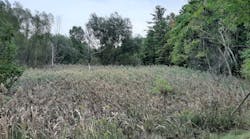Dust—it’s everywhere, and seems to accumulate literally from thin air. It seems harmless but it is anything but that. Dramatic photos that captured the devastation of the central plains Dust Bowl of the Great Depression are compelling evidence of how dry, vulnerable soil, transported by wind, transforms the landscape.
While we have learned much about controlling dust since then, dust is still with us every day. Whether it’s on your furniture, billowing from a construction or industrial site, or making your drive home on a country road hazardous, dust is a pervasive and unwanted fact of life.
But industrial dust is far more troublesome than the stuff on the dining room table. As these particles settle on waterways and vegetation they can harm the environment, and when inhaled by wildlife, livestock, and humans can cause respiratory distress. Numerous chemicals and hazardous materials that become airborne as a byproduct of commercial operations are also downright deadly.
The effect of dust from industry or commercial operations is further intensified by the conveyances taking their commodities to and from railheads or other destinations. The result is that over time, dust takes its toll as road surfaces literally blow away, contributing to erosion and frequent, costly surface repairs.
For decades, mitigating this nonpoint-source dust—”fugitive dust”—has been a daily nuisance. On mining, construction, demolition, and agricultural sites, at scrapyards, and on countless miles of unpaved roads across the country mitigation was routinely performed with water sprayers and hoses, often with added chemicals that in themselves were environmentally undesirable. “Keeping the dust down” was an inexact science. But with the passing of the 1970 Clean Air Act and 1972 Clean Water Act (CWA), fugitive dust was subject to increased regulation. Technology rallied to develop better methods and innovative products that today are key to controlling dust.
Engineering Dust Control
“The year 1975 was in a way the birth of the modern dust control industry,” says Bob Vitale, founder and CEO of Midwest Industrial Supply Inc. in Canton, OH. With the advent of the CWA, “A need arose for products to control dust that were non-dangerous to use, and non-harmful to human health.” But controlling dust requires a complex analysis of each situation, explains Vitale.
“For example, when you are a evaluating a situation such as dust coming off a road, you need to know several factors. How many miles are affected, how well is the road constructed, what are the materials the road is made out of? Then you need to know details of the road traffic. How many vehicles travel each day? How fast are they going? And how much do they typically weigh? These are a few of a number of data points that must be defined to know how the level of dust is generated and then to very deliberately define the type of dust control you want.”
Vitale’s company manufactures a number of products for dust control, such as Soil Sement, EnviroKleen, and EK35, each “with a different chemistry to fit a specific capability.”
“The polymer emulsion and binders of these products have tremendous engineering properties, and are within the field of nanotechnology,” he says. Vitale explains that the products are designed to “coat and bind all of the small particles and hold them together.” In effect this allows the treated surface to withstand wear, and as the products are water and sun resistant, the surfaces are very resilient to climate and weather.
“Our whole approach to solving dust and erosion is to keep the road where it belongs. All of our solutions are designed to work with the customer to find what process will work best to keep it that way.”
From roadways to runways, more than 35 specialized products provide users customized dust control. And controlling dust, in some instances, can literally save lives.


